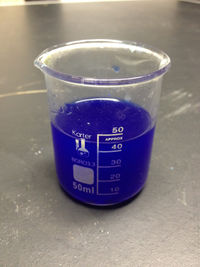Schweizer's reagent
 Schweizer's reagent in aqueous form
| |
| Names | |
|---|---|
| IUPAC name
Tetraammine copper(II) hydroxide dihydrate
| |
| Other names
Schweitzer's reagent
| |
| Properties | |
| [Cu(NH3)4(H2O)2](OH)2 | |
| Molar mass | 201.71 g/mol |
| Appearance | Deep blue (solution) |
| Melting point | Decomposes |
| Boiling point | Decomposes |
| Soluble | |
| Solubility | Reacts with acids Insoluble in organic solvents, may break down |
| Hazards | |
| Safety data sheet | None |
| Flash point | Non-flammable |
| Related compounds | |
| Related compounds
|
Copper(II) hydroxide |
| Except where otherwise noted, data are given for materials in their standard state (at 25 °C [77 °F], 100 kPa). | |
| Infobox references | |
Schweizer's reagent (sometimes written as Schweitzer's reagent) is a deep-blue solution of the coordination complex tetraammine copper(II) hydroxide, with the generally accepted formula [Cu(NH3)4(H2O)2](OH)2. This solution can be produced by dissolving copper(II) hydroxide in an excess of ammonia. It is notable for its ability to dissolve cellulose, and a solution of cellulose in Schweizer's reagent can be used to manufacture rayon fiber by injecting it into sulfuric acid solution.
The name Schweizer's reagent is also used for another compound, triphenylvinylphosphonium bromide, though they are very different compounds.
Contents
Properties
Chemical
Schweizer's reagent will decompose if heated to give off ammonia.
Physical
Schweizer's reagent is a deep-blue solution, with a strong ammonia smell. It can be dried in an ammonia stream, and its crystals are only stable under excess ammonia.
Availability
Schweizer's reagent is best made that purchased.
Preparation
Schweizer's reagent can be made by bubbling ammonia through a copper(II) hydroxide solution. Adding copper metal to a solution of ammonia also yields the complex, though this process takes a long time.
Projects
- Produce rayon
Handling
Safety
Tetraammine copper(II) hydroxide solutions give off ammonia fumes which are irritant and toxic.
It is also corrosive to copper and copper-based alloys, like brass and bronze.
Storage
Best stored in closed bottles or tubes, and kept away from heat. Dry crystals should be kept in an ammonia atmosphere in closed containers.
Disposal
Heating the compound causes it to release ammonia and leave behind copper(II) hydroxide or oxide. Do this outside or in a fumehood.
Alternatively, you can add an acid and convert the compound to ammonium and copper salts of the acid. Copper ions can be reduced to metallic copper which can be recycled, while ammonium salts can be either recycled or dumped in trash.